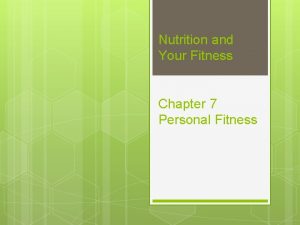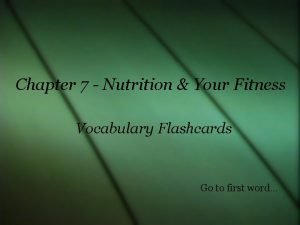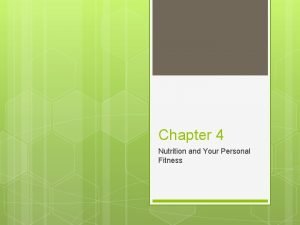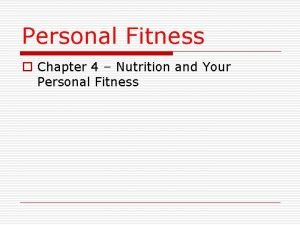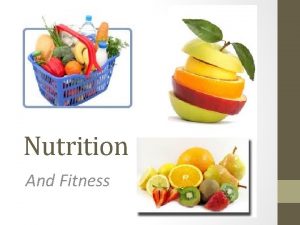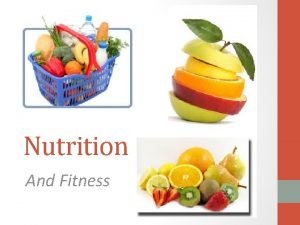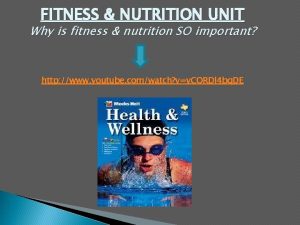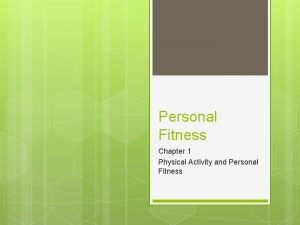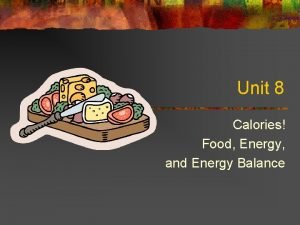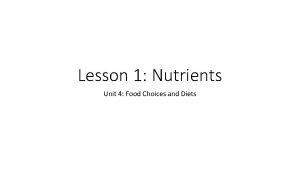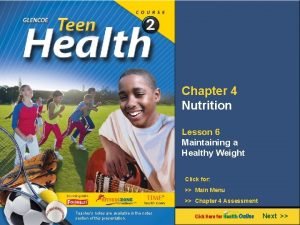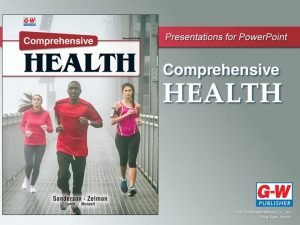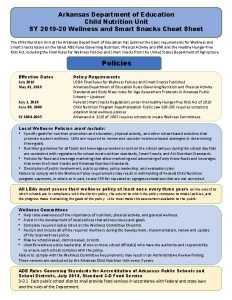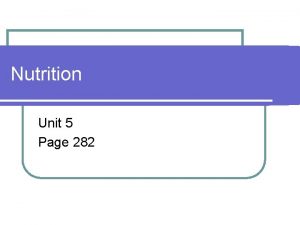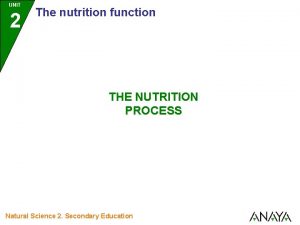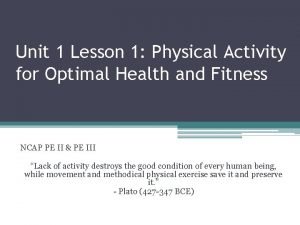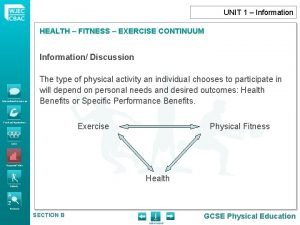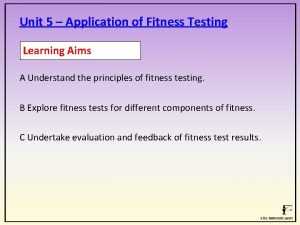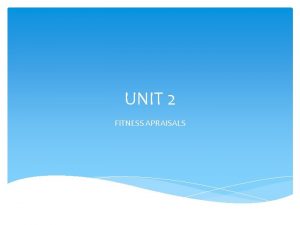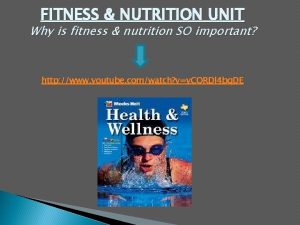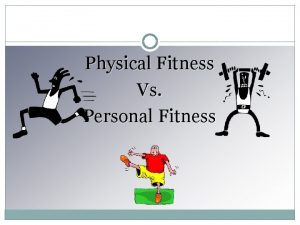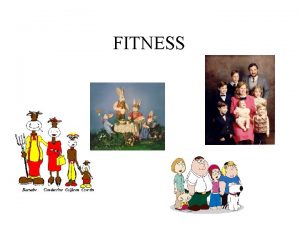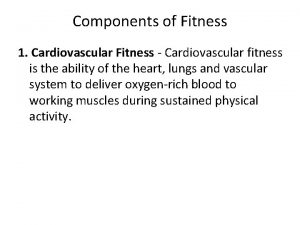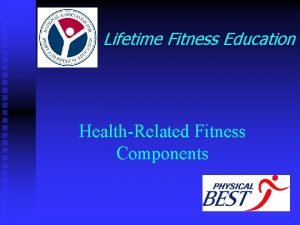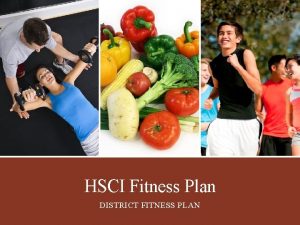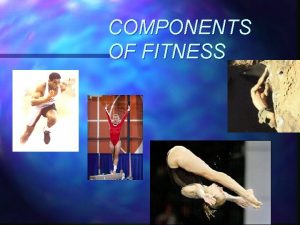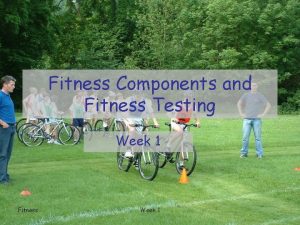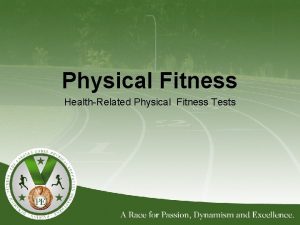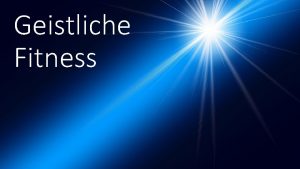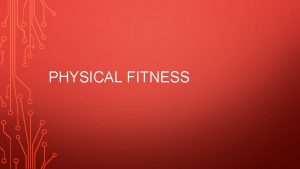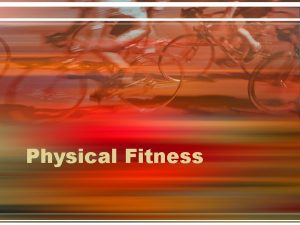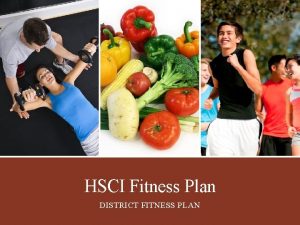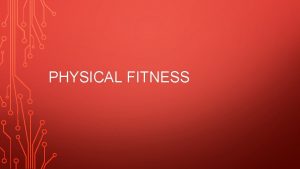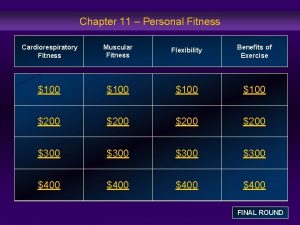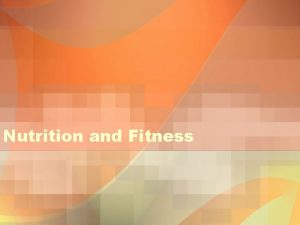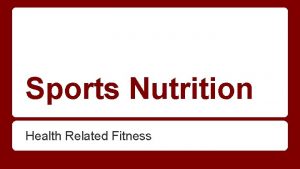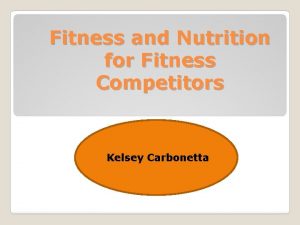FITNESS NUTRITION UNIT Why is fitness nutrition SO






























- Slides: 30

FITNESS & NUTRITION UNIT Why is fitness & nutrition SO important? http: //www. youtube. com/watch? v=v. CORDl 4 bq. DE

Benefits of Regular Physical Activity: � Brainstorm: In groups of 3 or 4 come up with as many benefits of regular physical activity as you can think of! � Select someone to write all your groups ideas down. � You have 10 minutes!

Benefits of Regular Physical Activity Physical Social Mental Condition of your body Increases/Improves: ØStrength ØEndurance ØBone Strength/Density ØEnergy ØHealth & Lung Endurance ØPosture ØSleep ØLife Expectancy Decreases: ØIllnesses/Sickness ØBlood Pressure ØBody Fat Relationships ØProvides opportunities to meet new people ØShare in a common goal ØDevelop a strong connection or bond with others ØTime to be with friends ØLearn about teamwork ØLearn compromise Dealing w/problems = Emotions Improves psychological well-being ØMood ØConfidence ØSelf-Esteem ØSelf-Image ØAlertness ØReduces Stress

Creating a Fitness Plan: � Set challenging but realistic goals � Choose exercises to best help you reach your goals � Begin exercising at a comfortable level � Do a variety of exercises � Follow ◦ ◦ ◦ the Training Principles: Principle of Warm up Principle of Cool down Principle of Specificity Principle of Overload Principle of Progression Principle of Fitness Reversibility

Warm-up Specificity A workout should include a specific type of exercise to gain the desired fitness benefit Fitness Reversibility Fitness Benefits are lost when training stops 5 -10 minutes of easy exercise to warm and stretch muscles & increase blood flow TRAINING PRINCIPLES Cool-Down 5 -10 minutes of reduced exercise to help the heart rate & breathing rate, temperature, & circulation return to normal Overload Workout must include exercise beyond what is usually done to gain additional fitness benefits Progression Amount and intensity of exercise in a workout must be increased gradually

Exercise Prescription Your Exercise Prescription ü Very similar to a medical prescription. A medical prescription will include the name of the medicine, the dose needed, and how often the medicine should be taken. ü The exercise prescription is a breakdown of how often you need to work, how hard, the length of time per session, and the type of activity or exercise performed. These factors of exercise prescription are referred to as the principles of training or FITT principles.

The F. I. T. T. Principle/Formula üDEFINITION: Guidelines that help you set up a workout routine to fit your goals and fitness level üHelp you get the most out of your exercise program

FREQUENCY �Refers to the number of times per week you engage in physical activity or exercise. �HOW OFTEN

INTENSITY �Refers to the difficulty or exertion level of your physical activity or exercise. �HOW HARD �Target Heart Rate � 220 -Age

TIME �Refers to the duration of a single workout, usually measured in minutes or hours. �HOW LONG

TYPE �Refers to the particular type of physical activity or exercise you choose to do. �WHAT KIND

Physical Fitness Body’s ability to perform activity and to meet the demands of daily living while being energetic and alert. � Exercise is planned, structured and repetitive bodily movement done to improve or maintain one or more of the 5 components � 2 main kinds of exercise: ◦ Aerobic ◦ Anaerobic � Consists of 5 components of Health Related Fitness

AEROBIC EXERCISE

ANAEROBIC EXERCISE � � Anaerobic means “without air” or “without oxygen. ” Anaerobic exercise is short-lasting, high-intensity activity, where your body’s demand for oxygen exceeds the oxygen supply available. Anaerobic exercise relies on energy sources that are stored in the muscles and, unlike aerobic exercise, is not dependent on oxygen from (breathing) the air. Examples include: heavy weight-lifting, all types of sprints (running, biking, etc. ), interval training, or any rapid burst of hard exercise.

Health Related Fitness - the ability of the heart, lungs, muscles, & joints to function optimally. 5 Components of Health-Related Fitness � Cardio-Respiratory � Muscular Endurance Strength � Muscular Endurance � Flexibility � Body Composition

Cardio-Respiratory Endurance • The ability of the circulatory and respiratory systems to supply oxygen during continuous physical activity • Helps your heart and lungs function more efficiently and improved your metabolic rate

Cardio-Respiratory Endurance � Frequency ◦ 3 -5 times per week � Intensity ◦ 60 -85% of target heart rate zone � Time ◦ 20 -60 minutes per session � Type ◦ Any aerobic activity that increases heart rate

Examples of Exercises to Improve Cardio-Respiratory Endurance � Running/Pacer � Jumping Rope � Ultimate Football � Soccer � Biking � Dancing � Lance Armstrong-Tour de France ◦ http: //www. youtube. com/watch? v=FXPXHK 7 I 1 i. Q

Muscular Strength � The maximum amount of force a muscle can produce in a single effort � How much you can lift, pull, push � How much power or force can you exert � ANEROBIC EXERCISE

Muscular Strength � Frequency ◦ 2 -4 times per week � Intensity ◦ Heavier weight with less repetitions � Time ◦ 30 -60 minutes per session � Type ◦ Anaerobic activities such as weight room

Examples of Exercise to Improve Muscular Strength � Weights -Max lifting ◦ Squats ◦ Deadlift ◦ Bench Press � Push-ups � Pull-ups � World’s Strongest Man ◦ http: //www. youtube. com/watch? v =7 mq. Sqw. GJAMg

Muscular Endurance � Ability of the muscles to perform physical tasks over a period of time without becoming fatigued

Muscular Endurance � Frequency ◦ 2 -4 times per week � Intensity ◦ Light weights, numerous reps � Time ◦ 30 -60 minutes per session � Type ◦ Any activity allowing muscles to perform a physical task for a period of time

Examples of Exercise to Improve Muscular Endurance � Weights � Running/jogging � Swimming � Cycling � Pilates/Yoga � Push-up & Curl-up tests � Triathlons and Decathlons � Ironman Race ◦ http: //www. youtube. com/watch? v=WEo. Sd Rv. JQ 0 Q

Flexibility � � The ability to bend and move the joints through a full range of motion. Benefits of good flexibility: ◦ ◦ ◦ ◦ Improved Performance Decreased Injury Risk Reduced Muscle Soreness Improved Posture Reduced Risk of Low Back Pain Increased Blood and Nutrients to Tissues Improved Muscle Coordination Enhanced Enjoyment of Physical Activities

Flexibility � Frequency ◦ Daily stretching � Intensity ◦ Stretch muscles and hold beyond its normal length at a comfortable stretch � Time ◦ Hold each stretch 10 -15 seconds; stretch 15 -30 minutes daily � Type ◦ Stretching allowing full range of motion

Examples of Exercise to Improve Flexibility �Dynamic Stretching �Static Stretching �Pilates �Yoga �Gymnastics � Gabby Douglass ◦ http: //www. youtube. com/watch? v= bm. WICdhvy. Jw&feature=relmfu

Body Composition � � � Body Composition is the percentage of body fat compared to the percentage of lean muscle tissue. A body composition within the recommended range suggests you have less risk of developing obesity-related diseases such as diabetes, high blood pressure, and even some cancers. When we drop below the minimal recommended levels of essential fat, we negatively affect the delivery of vitamins to the organs, the ability of the reproductive system to function, and overall well-being.

� Body Composition can be measured in different ways: ◦ Body Mass Index (BMI) ◦ Waist to Hip Ratio (WHR) ◦ Skinfold Caliper Test

Lifetime Fitness Sports & Activities � Can be done at almost any age throughout life � Can be done at almost any fitness level � Some requires little/no equipment � Some can be low to no cost ◦ Examples: �Swimming �Running/Jogging �Walking �Cross County Skiing �Golf �Biking �Martial Arts
 Why why why why
Why why why why Dont ask why why why
Dont ask why why why Chapter 7 nutrition and your fitness
Chapter 7 nutrition and your fitness Chapter 7 nutrition and your fitness
Chapter 7 nutrition and your fitness Chapter 4 nutrition and your personal fitness
Chapter 4 nutrition and your personal fitness Fitness & nutrition
Fitness & nutrition Seven nutrition and fitness
Seven nutrition and fitness Deakin credit for prior learning
Deakin credit for prior learning Fitness & nutrition
Fitness & nutrition Fitness & nutrition
Fitness & nutrition Fitness & nutrition
Fitness & nutrition Fitness & nutrition
Fitness & nutrition Fitness & nutrition
Fitness & nutrition Health-related skills
Health-related skills Unit 10, unit 10 review tests, unit 10 general test
Unit 10, unit 10 review tests, unit 10 general test Chapter 1 why personal fitness
Chapter 1 why personal fitness Biobeyond unit 8 nutrition lab counting calories
Biobeyond unit 8 nutrition lab counting calories Food and nutrition unit 4
Food and nutrition unit 4 Food and nutrition unit 4
Food and nutrition unit 4 Unit 3 nutrition lesson 6 anorexia nervosa and bulimia
Unit 3 nutrition lesson 6 anorexia nervosa and bulimia Unit 3 nutrition lesson 4 weight control
Unit 3 nutrition lesson 4 weight control Arkansas department of education child nutrition unit
Arkansas department of education child nutrition unit Teks anatomy and physiology
Teks anatomy and physiology Food and nutrition unit 5
Food and nutrition unit 5 Nutrition unit 2
Nutrition unit 2 Child nutrition unit arkansas
Child nutrition unit arkansas Unit 26 animal anatomy physiology and nutrition
Unit 26 animal anatomy physiology and nutrition Unit 1 lesson 1 the importance of fitness
Unit 1 lesson 1 the importance of fitness Exercise continuum
Exercise continuum Hand wall toss test normative data
Hand wall toss test normative data Unit2fitness
Unit2fitness


